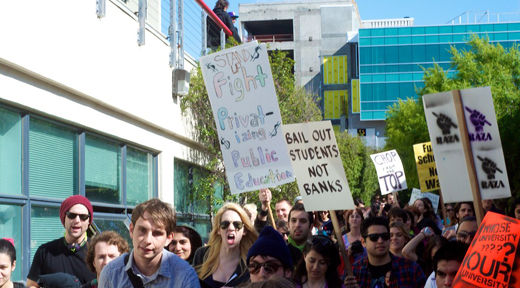
Young people and their parents had two reasons to celebrate yesterday’s passage of the sweeping health care reform bill. In addition to extending the age limit under which children are covered by parents’ insurance from 18 to 26, the bill included a historic change in college financial aid.
For four decades, the student loan program has relied on private lenders, which were both subsidized and guaranteed by the government. The bill (an updated form of the Student Aid and Fiscal Responsibility Act), removes those “middlemen” from the equation, at a projected savings of $61 billion dollars.
The United States Student Association (USSA) campaigned hard for the change, calling it “inexcusable to continue the current student loan system, which is nothing more than corporate welfare.”
Other organizations working for passage of the bill included the NAACP, the Leadership Conference on Civil and Human Rights, and the National Council of La Raza.
Rep. George Miller (D-CA), called the legislation “the single largest investment in college affordability ever at no cost to the taxpayers.”
The savings from the change will go towards increasing Pell Grants and funding of higher education institutions, including the historically Black colleges and community colleges, which will receive $4 billion.
In addition, $1.5 billion will be used to make it easier for student borrowers to repay their loans.
The bill will increase Pell Grants each year by the consumer price index, but proposes no additional increases over the next two years and a modest increase over the five years that follow. The maximum grant will now increase to $5,900.
These levels are less than President Obama and House Democrats had wanted. The original proposal – to add an additional 1% over and above the consumer price index – was scrapped due to Republican opposition, as was the proposal to increase the maximum grant to $6,900.
$13.5 billion is earmarked help fill a $19 billion Pell Grant shortfall caused by the unemployment crisis and resulting influx of students pursuing new career training.
USSA has cautioned that “opponents of student aid reform are gearing up for a fight,” and has an online letter campaign aimed at the Senate, which will vote later this week.
Republican opposition to the bill is clearly based on allegiance to the bottom line for the banks, which under the old system received billions every year from the federal government to originate loans and also guaranteed loan repayment up to 97 percent.
Inclusion of the education bill in the health care reconciliation was a key part of the Democrats’ strategy for winning. In order to use the reconciliation method, it must be proven that the measure can help produce $1 billion in deficit savings over each of the next 10 years.
The health care bill alone would not have been able to show this savings, but the insertion of the education bill met that requirement.
Some of the savings ($19 billion) from cutting the private lenders out of the student loan system will go to deficit reduction and to offset expenses in the health care legislation.







Comments